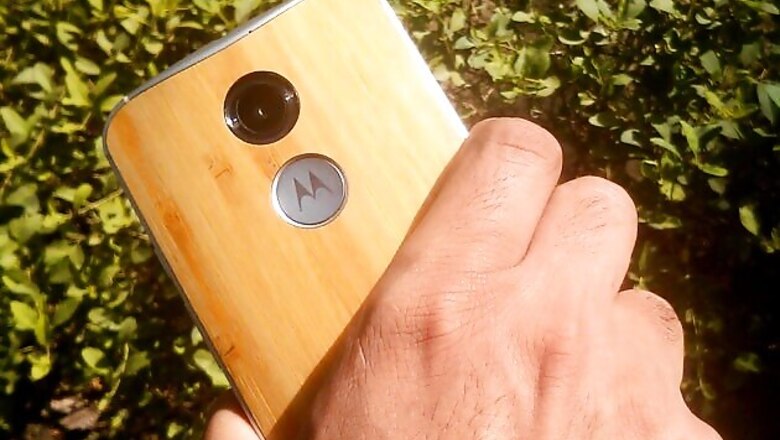
views
In times when flagship phones from leading smartphone makers are coming at prices close to half-a-lakh, Motorola has been releasing its top-of-the-line phones with price tags way lower than the competition. Motorola appears to have the right mix of hardware and software in what it brews, while keeping aside the gimmicks that only add to the cost.
The Rs 31,999 new Motorola flagship Moto X is another example of Motorola's smart pricing. But does this competitively priced flagship have in it what it takes to give its rivals a run for their money? Read on.
The new Moto X (second-gen) comes with 16GB of storage and is available in three variants - regular black, black leather, and bamboo white. The first one is priced at Rs 31,999, while the other two carry a price tag of Rs 33,999. The model that we got to review was the one with the wood finish.
The new Moto X may have a beautiful display with a frontal speaker, but what attracted me in the first place was its bamboo rear shell, which makes the phone appear both classy and quirky at the same time. Its curved back, making the phone thinnest on the edges and thickest in the middle, makes it easy to grip the phone, but its mammoth 5.2-inch display takes away the ease of operating the phone with a single hand - something that is a deterrent in most large-screen phones. Adding to its beauty is a metal frame that wraps around the phone - separating the bamboo back from the front that is white in colour.
Its 5.2-inch AMOLED display with a screen resolution of 1920x1080 pixels produces vivid colours and strong contrast. From browsing the Internet to replying to emails to reading books to watching videos, it was all smooth and pleasant. With Corning Gorilla Glass atop, the display is protected against scratches.
It was all going great with the phone until I put its 13 megapixel rear camera to test in low- and soft-light conditions. The same camera that surprised me with its quality in daylight, disappointed me when I started to snap pictures in a decently lit room. The results were all grainy. The Nexus 5 performed far better in the same lighting conditions. The 13-megapixel camera at the rear comes with a dual-LED ring flash to throw balanced light. The flash while did a decent job in illuminating the otherwise dark area, it couldn't do much in reducing noise in pictures. The phone's 2-megapixel front camera is apt for video calling.
The burst mode is one of the key highlights of the new Moto X's camera. It lets you take multiple shots in one go just by holding down on display, helping you capture the best shot. I used it most of the time in capturing fast-moving subjects.
Unlike the flagships of today, the new Moto X does not come with a wide range of camera features on board. But then it can not be seen as a downside given that only a handful of those ample camera features are actually used - with rest of them are either tagged gimmicks or simply don't come to use in practical application.
Slow-motion, ultra HD (4K) videos, HDR and Panorama are some other features of the Moto X's camera app.
In India, the new Moto X only comes with 16GB of storage (out of which around 10 GB is user accessible) with no expansion capability. The 16GB of memory space may appear to be too much in the beginning, but in reality, this amount of storage space is unlikely to suffice a power user. It would have been better had it come with minimum of 32GB of internal storage.
At its heart is a 2.5GHz Qualcomm Snapdragon 801 with quad-core CPU paired with 2GB of RAM. The powerful processor powering the Moto X is the one you will find in the Sony Xperia Z3, LG G3, Samsung Galaxy S5 and other high-end phones from key rivals. The monster beating under the hood made my experience smooth and delivered a performance free of lags and freezes.
Running Android 4.4.4 KitKat, the phone offers experience close to native Android. This is something we have seen on other Motorola phones also. (The new Moto X will be one of the first phones to receive Android 5.0 Lollipop update. Motorola says to release the update soon.)
With the view to improve user experience, the company has included a few gesture controls in the new Moto X, with only a couple of them proved to be handy. For instance, it lets you silence calls and snooze alarms simply by waving your hand; you can twist your wrist twice quickly to launch the camera app - without even going to the lock screen.
Setting up voice to control the phone hands-free didn't work for me. First it asked me to look for a quiet place so I had to wait for that moment when I was alone and it was all quiet around me. When I found myself in a quiet environment and started the process, it failed to pick out the phrase I was using to set up voice and instead told me I was speaking it too loudly. After various attempts I gave up. I tried the same after a few days, but in vain.
The phone that accommodates a nano SIM has a powerful speaker at the front which generated clear and loud results - even in noisy environments.
The second-gen Moto X has its own set of cons, but its aggressive pricing is what makes it a worthy rival.
Word of advice: If you are an avid mobile photographer, you can give this phone a skip.
Tech Specs: Moto X (2nd generation)
Operating System: Android 4.4.4 KitKat
Storage: 16GB
Rear Camera: 13 megapixel/ f/2.25 aperture
Front camera: 2 megapixel
Battery: 2300mAh (mixed usage up to 24 hours)
Bluetooth technology: Bluetooth version 4.0 LE
Display: 5.2-inch AMOLED, 1080p Full HD, 423 ppi, Corning Gorilla Glass 3
Processor: 2.5GHz Qualcomm Snapdragon 801 with quad-core CPU (MSM 8974-AC), Adreno 330 @ 578 MHz GPU,
RAM: 2GB
SIM card: Nano SIM




















Comments
0 comment